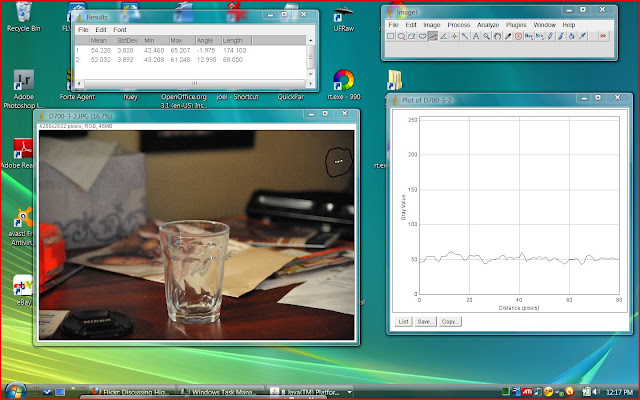Quick question. Which patch has the least amount of noise. The one with the line profile under the image? Or the one with the line profile beside the image?
Actually nether. It's the same patch. In the bottom graph I measured 125 pixels. In the side graph I dragged the line out so I measured 1200 pixels. Because ten times more noise wiggles were compress together the line is darker and looks noisier. This complicates things especially when comparing cameras with differing numbers of pixels.
From now on graphs are for info only. I'll be posting result boxes showing the rms mean value (signal) and sdev (standard deviation or noise) Using these numbers I'll calculate the S/N numbers for any comparisons.
Yesterday I ate a few crow feathers in the D7000 thread. I'd blindly taken imaging-resource's word that they had measure the lighting for the D700 ISO6400 image. One look at the EXIF info and it was obvious that instead of 11 lumens, the lighting you find on a well lite street at night--the lighting used was more like 30 lumens.
My only excuse for such a stupid mistake is up to now I have been using my blog as an online lab notebook. So I was free to changed my mine latter if I goofed. After all nobody read my theoretical posts. Until this one caught peoples' attention. So my apologies for any confusion and on to what really is happening.
A way to correct for the lighting differences was to search out for areas in the images that had the same signal and then compare the noise. When I did it for the highlights, the black circled areas, it was definitely Oops. The D700 beat out the D7000 by coincidentally 1.44--the magic noise number for a pixel twice bigger than the D7000's pixel.
Things become more interesting when I did the same thing for the shadows. I chose the second dark patch for the D700 (blue) and an area on the frame of the Dave Box for the D7000 (red). The result box says it all. Down in the shadows the S/N was identical.
I suddenly had some interesting ideas on what was going on, but since I was dealing with one set of suspect data, I certainly didn't have a convincing case. Even in my own mind.
Then d.brodsky posted a link to his images of the same scene, one taken with a D7000 and one with a D700. He provided a second data set.
(Click on the clips for full size and readable images)
The EXIF info says the images were taken with two different lens so the exposures weren't exactly identical but I did find areas where the signal values were close. The result boxes show that with real world images the noise reduction in the two cameras can smooth the noise out to were the signal to noise is nearly identical.
So my current thinking that Nikon's noise reductions routines are sophisticated. Besides the obvious settings-- off, low, normal and high-- the algorithm looks at the S/N in the various areas of the image. If it is in a highlight were the S/N is high it uses little or no noise reduction. If it is the shadows it uses a lot.
So if you compare images by looking at the bright areas where the noise is easy to see, the pixel size difference is important. But if you are digging detail out of the shadows the two camera may give the same results.
My plans are to uses my D7000 to figure out what is going on. But it might be a while before I post again since the computer I'm working with is going back to the shop for warranty repairs. Who knows how long that will take.
And finally a special thanks to d.brodsky for sharing his images.




No comments:
Post a Comment